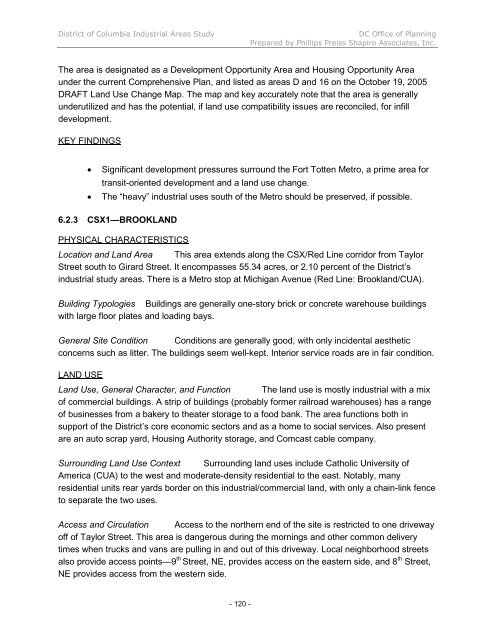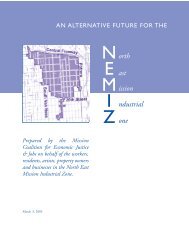INDUSTRIAL LAND IN A POST-INDUSTRIAL CITY District of ...
INDUSTRIAL LAND IN A POST-INDUSTRIAL CITY District of ...
INDUSTRIAL LAND IN A POST-INDUSTRIAL CITY District of ...
Create successful ePaper yourself
Turn your PDF publications into a flip-book with our unique Google optimized e-Paper software.
<strong>District</strong> <strong>of</strong> Columbia Industrial Areas Study DC Office <strong>of</strong> Planning<br />
Prepared by Phillips Preiss Shapiro Associates, Inc.<br />
The area is designated as a Development Opportunity Area and Housing Opportunity Area<br />
under the current Comprehensive Plan, and listed as areas D and 16 on the October 19, 2005<br />
DRAFT Land Use Change Map. The map and key accurately note that the area is generally<br />
underutilized and has the potential, if land use compatibility issues are reconciled, for infill<br />
development.<br />
KEY F<strong>IN</strong>D<strong>IN</strong>GS<br />
Significant development pressures surround the Fort Totten Metro, a prime area for<br />
transit-oriented development and a land use change.<br />
The “heavy” industrial uses south <strong>of</strong> the Metro should be preserved, if possible.<br />
6.2.3 CSX1—BROOK<strong>LAND</strong><br />
PHYSICAL CHARACTERISTICS<br />
Location and Land Area This area extends along the CSX/Red Line corridor from Taylor<br />
Street south to Girard Street. It encompasses 55.34 acres, or 2.10 percent <strong>of</strong> the <strong>District</strong>’s<br />
industrial study areas. There is a Metro stop at Michigan Avenue (Red Line: Brookland/CUA).<br />
Building Typologies Buildings are generally one-story brick or concrete warehouse buildings<br />
with large floor plates and loading bays.<br />
General Site Condition Conditions are generally good, with only incidental aesthetic<br />
concerns such as litter. The buildings seem well-kept. Interior service roads are in fair condition.<br />
<strong>LAND</strong> USE<br />
Land Use, General Character, and Function The land use is mostly industrial with a mix<br />
<strong>of</strong> commercial buildings. A strip <strong>of</strong> buildings (probably former railroad warehouses) has a range<br />
<strong>of</strong> businesses from a bakery to theater storage to a food bank. The area functions both in<br />
support <strong>of</strong> the <strong>District</strong>’s core economic sectors and as a home to social services. Also present<br />
are an auto scrap yard, Housing Authority storage, and Comcast cable company.<br />
Surrounding Land Use Context Surrounding land uses include Catholic University <strong>of</strong><br />
America (CUA) to the west and moderate-density residential to the east. Notably, many<br />
residential units rear yards border on this industrial/commercial land, with only a chain-link fence<br />
to separate the two uses.<br />
Access and Circulation Access to the northern end <strong>of</strong> the site is restricted to one driveway<br />
<strong>of</strong>f <strong>of</strong> Taylor Street. This area is dangerous during the mornings and other common delivery<br />
times when trucks and vans are pulling in and out <strong>of</strong> this driveway. Local neighborhood streets<br />
also provide access points—9 th Street, NE, provides access on the eastern side, and 8 th Street,<br />
NE provides access from the western side.<br />
- 120 -












